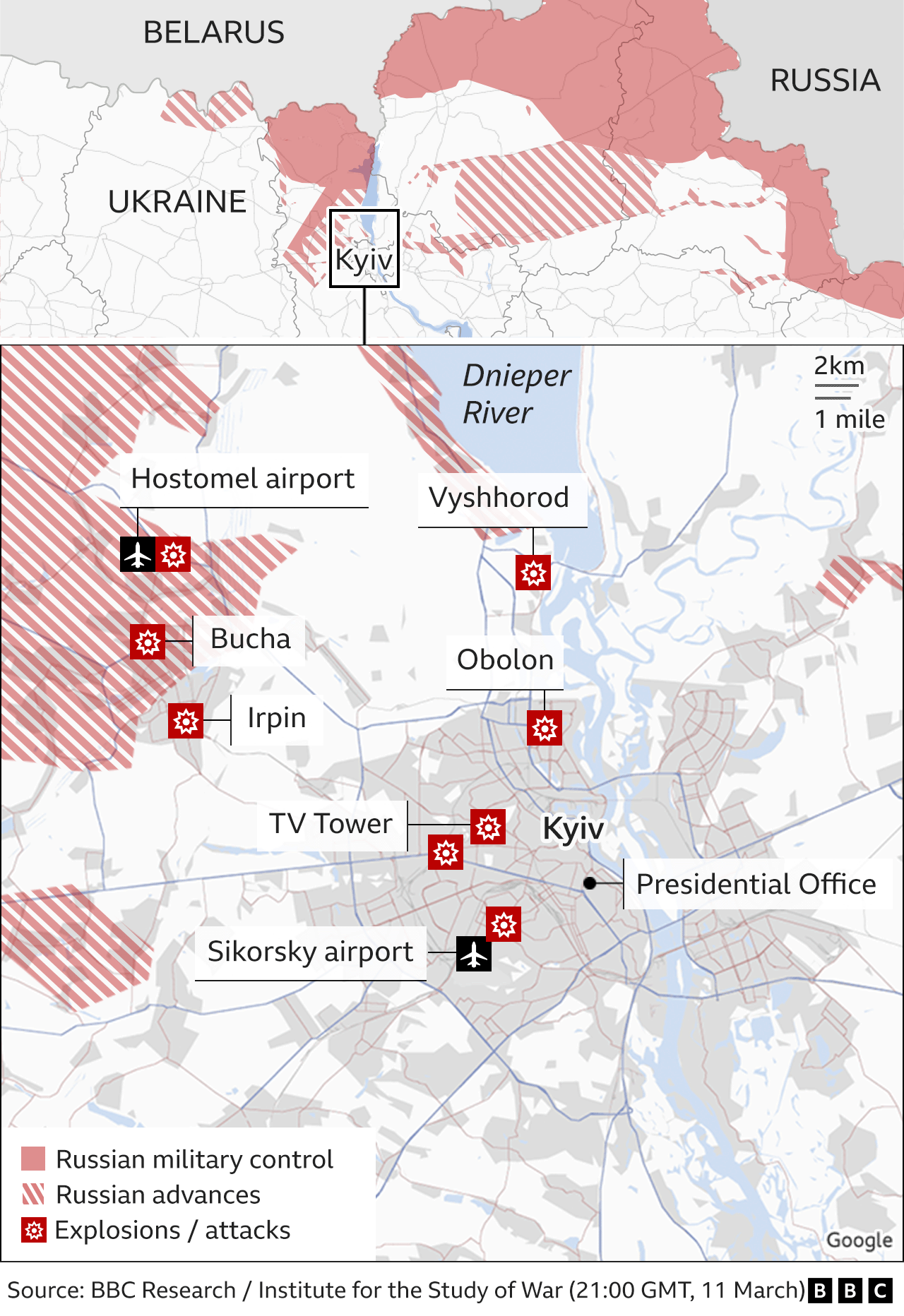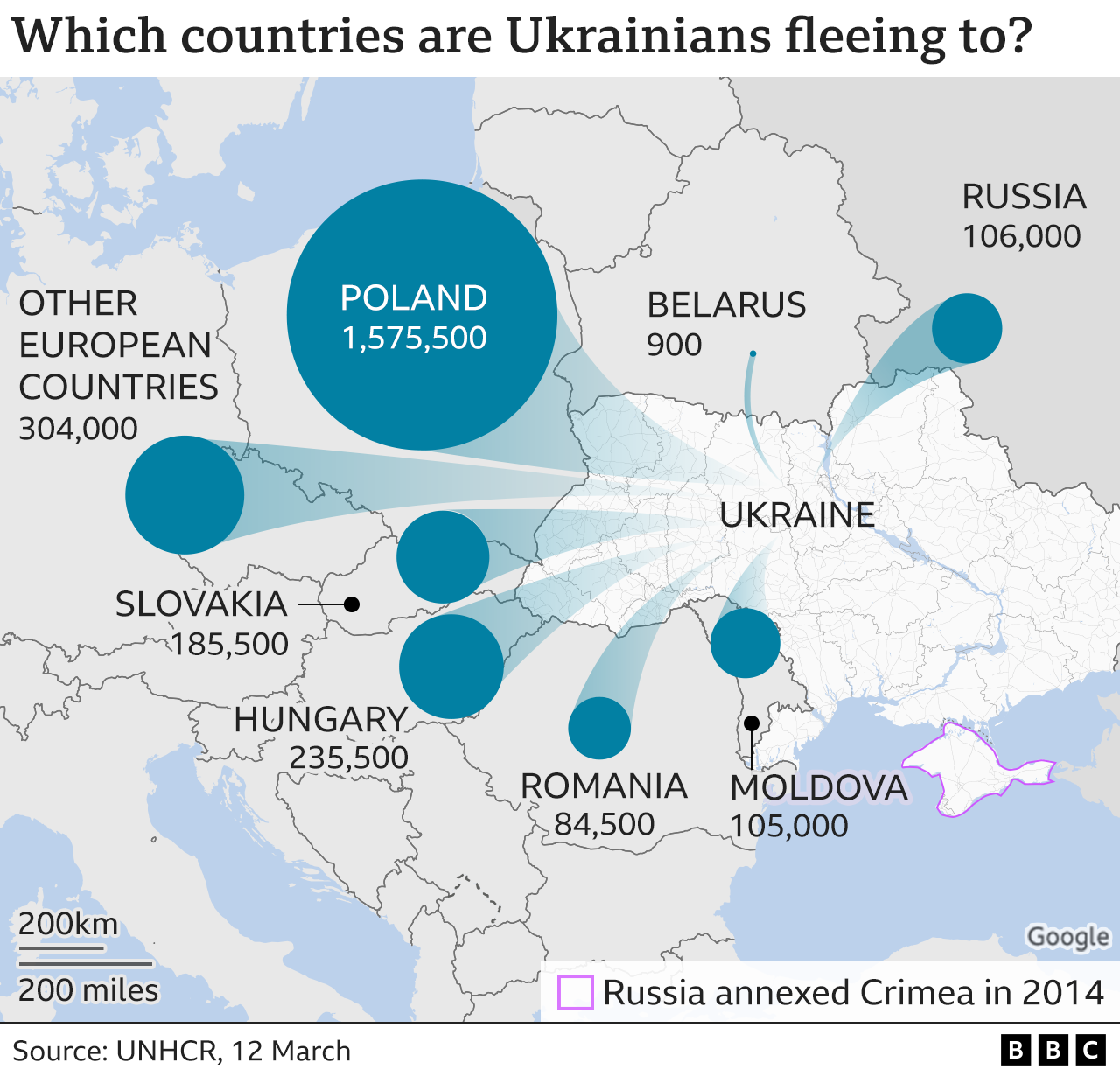BBC News 12 March 2022 - by the Visual Journalism Team
Russian troops have expanded their offensive across Ukraine as they continue attempts to encircle and cut off the capital Kyiv.
Here are the latest developments on day 17 of the invasion:
- Intense fighting to the north-west of the capital Kyiv
- Russian forces are now 25km (15 miles) from the capital
- Mykolaiv in the south-west of Ukraine is under heavy bombardment
- Southern city of Mariupol continues to be besieged and is without power
- New artillery and air attacks on the cities of Dnipro and Kropyvnytskyi
Russia launched its attack in the early hours of 24 February from three main directions: north, south and east.
Targets all over the country have been attacked from land, sea and air.
The fight for Kyiv
Russian forces are attempting to encircle and cut off the Ukrainian capital, with troops now moving towards the city from multiple positions.
Recent satellite imagery shows that after days of sitting idle on an arterial road north of the city, a massive Russian armoured column has now moved southwards, dispersing into forests outside Kyiv and moving its artillery and rocket launchers to within range of the capital.
A failure to take Kyiv would mean a failure of the whole campaign, with dangerous political consequences for Mr. Putin back home, according to the BBC's Security Correspondent Frank Gardner
The city is bracing itself for an assault, with Ukrainian forces and volunteers building new defences and creating barricades on major routes to slow any Russian attack.
An advance by Russian troops heading for the capital from Sumy in the east has also made some significant progress in recent days.
The movement around Kyiv suggests Russian troops may be preparing for a siege of Kyiv rather than a full-on assault, according to Dr Jack Watling, of the Royal United Services Institute, a defence think tank.
Slow Russian progress in the north
Although Russian troops are now making gains on the outskirts of Kyiv, their progress in the north has been much slower than in the south.
The main advance towards the capital initially came from Belarus down the west side of the Dnieper River via Chernobyl.
The large Russian column heading for Kyiv faced strong resistance after reaching Hostomel airport to the north west and also suffered logistical issues, including a shortage of fuel.
To the north east, Russian forces have continued efforts to take the city of Chernihiv, pummelling it with shells and rockets and reducing parts to rubble, but have yet to advance down the east bank of the Dnieper River.
Big Russian gains in the south
Russian forces have made rapid gains across the south of the country, advancing east and west from Crimea.
In the south-east, there is growing concern for tens of thousands of civilians trapped in the port city of Mariupol, which is encircled by Russian forces.
It has held out since the early days of the invasion but at huge cost. The UN says civilians in the city "desperately need aid, especially life-saving medical supplies".
People are trapped without food, running water or electricity and bodies have been buried in mass graves.
Russian forces advancing from Kherson are now firing on Mykolayiv as they move west.
The BBC's Security Correspondent Frank Gardner says the prize here for Russia is the strategic port city of Odesa to the southwest: "The city has had plenty of time to build its defences but if and when Russia does attack it will likely be a multi-pronged assault using amphibious forces in the Black Sea combined with air mobile units deployed inland. If Odesa is captured it would effectively cut Ukraine off from the sea."
New air strikes in the east
Explosions were heard in Dnipro, a key city on the Dneiper River, on Friday morning - the first time Russia has targeted it since its invasion.
Attacks resumed on Saturday morning with air raid sirens heard across the city.
Dnipro is full of heavy industry - including a rocket factory - and is strategically important as a point of convergence for Russian troops coming from the south and east.
Kharkiv, the second-largest city in Ukraine, continues to face intense aerial bombardment but Russia has not renewed attempts to take the city.
Artillery attacks on residential areas of the city are being investigated by United Nations (UN) prosecutors for possible war crimes.
Russian forces in the area have continued operations to the south east of the city, analysts say, with efforts launched to seize Izyum.
Thousands flee across borders
Since the invasion began, more than 2.5 million people have fled Ukraine, according to the UN.
It is the fastest-growing refugee crisis in Europe since World War Two.
Unicef, the UN children's agency, believes around half of them are children and young people.
By David Brown, Bella Hurrell, Dominic Bailey, Mike Hills, Lucy Rodgers, Paul Sargeant, Mark Bryson, Zoe Bartholomew, Sean Willmott, Sana Dionysiou, Joy Roxas, Gerry Fletcher and Jana Tauschinski.
About these maps
To indicate which parts of Ukraine are under control by Russian troops we are using daily assessments published by the Institute for the Study of War with the American Enterprise Institute's Critical Threats Project.
From 2 March this daily assessment differentiated between "Assessed Russian-controlled Ukrainian territory" and "Assessed Russian advances in Ukraine", the latter indicating areas where Russians are believed to have launched attacks from but which they do not control.
To show key areas where advances are taking place we are also using daily updates from the UK Ministry of Defence and BBC research. To show locations where there have been attacks or explosions we are using reports that have been verified by the BBC.
The situation in Ukraine is fast moving and it is likely there will be times when there have been changes not reflected in the maps.







